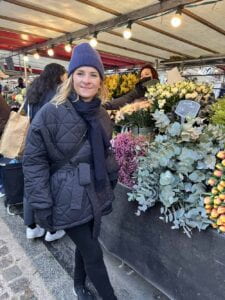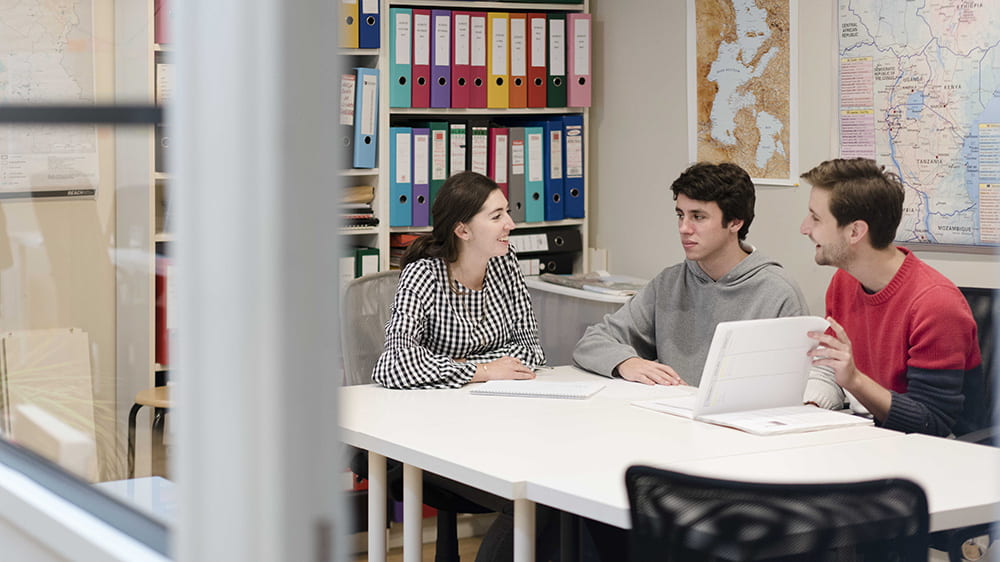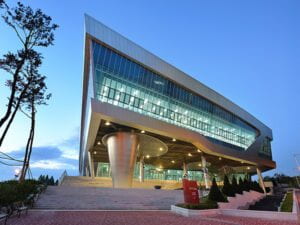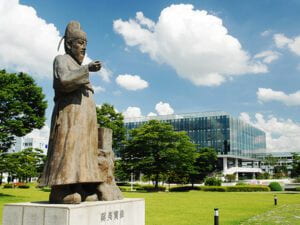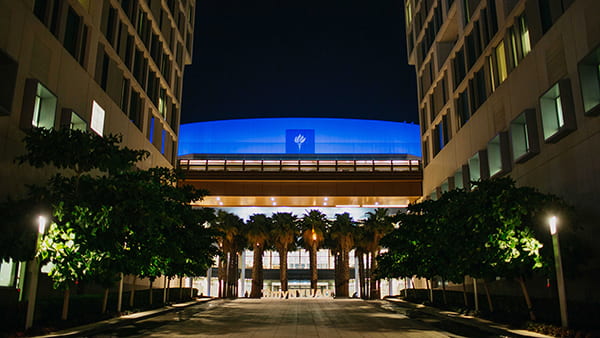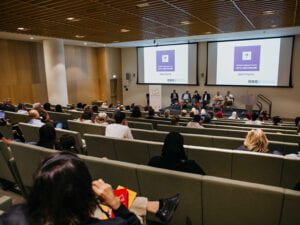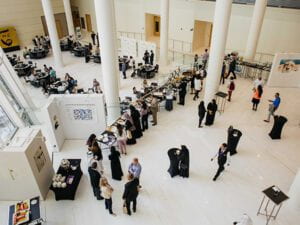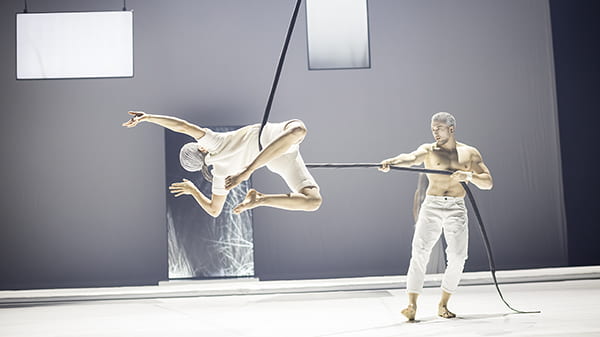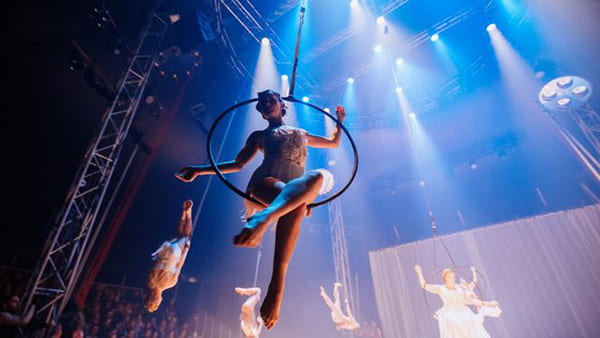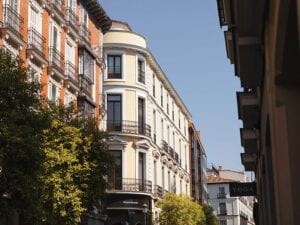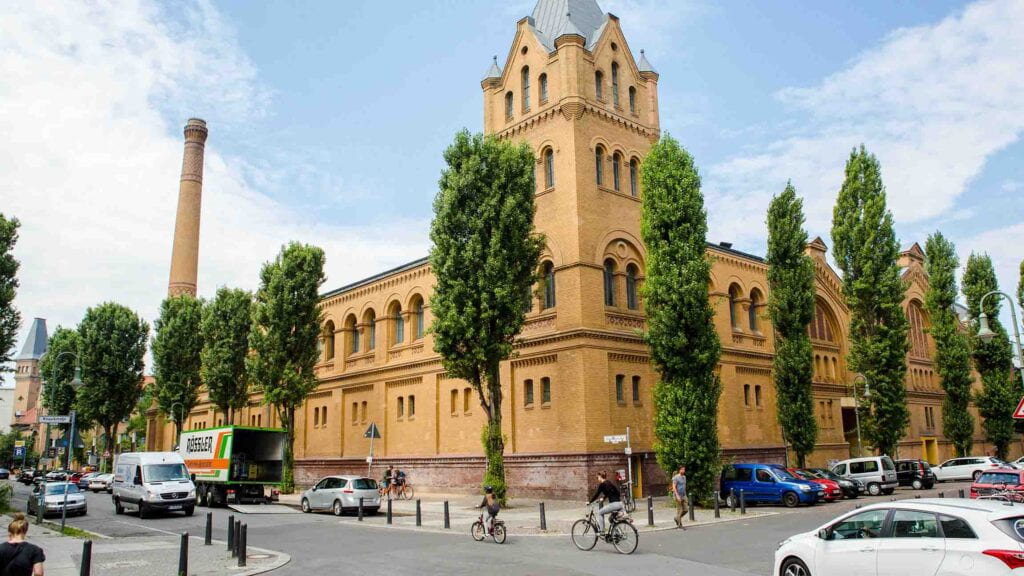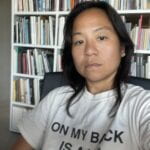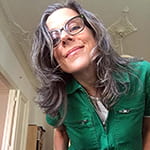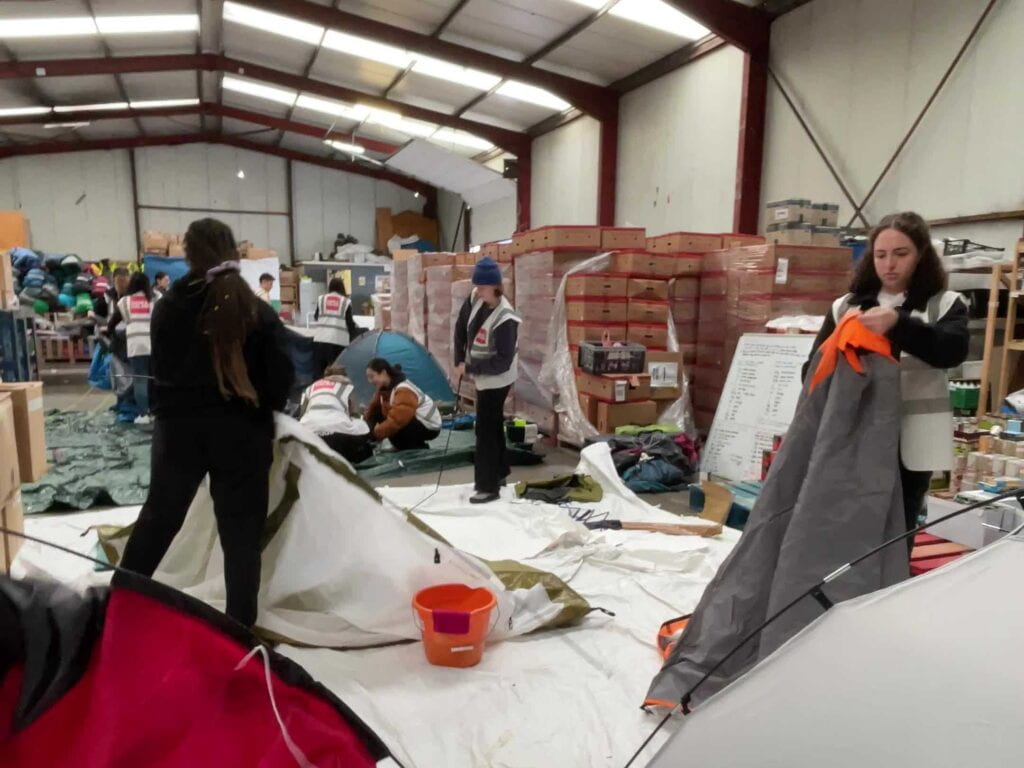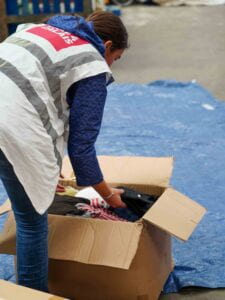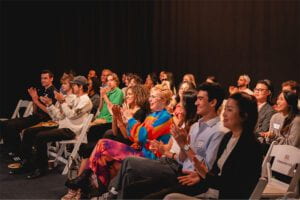Follow Music Business major Antonio, a junior at the Steinhardt School of Culture, Education, and Human Development, as he shares a typical day studying at NYU Prague, including insight into his internship at the Bohuslav Martinů Institute, where he helps preserve the Czech composer’s body of work.
Global Dimensions
News and notes from across NYU's Campuses and Sites
The Global Liberal Studies Course Taught Around the World
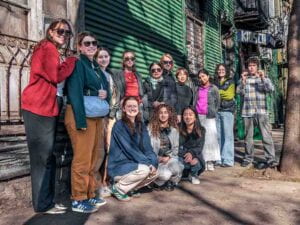
Students in Cecilia Palmeiro’s “City as Text” class in Buenos Aires’ La Boca neighborhood. The class studies its traditional tenements—painted in different colors—in reading the history of Buenos Aires through its architecture. Photo credit: Daniel Espinoza
Global Liberal Studies (GLS) majors have the unique opportunity to take the course City As Text during the fall semester at most locations in NYU’s global network. The course, part of the GLS junior-year learning sequence, selects location-specific texts to immerse students in the setting where they’re living and learning. “Across all City As Text courses, emphasis is placed on the importance of primary sources. Students academically investigate their present geographic setting but also experience its profound intricacies on-site. The classroom work, alongside the field trips, is designed to facilitate the framing and contextualization of the study away experience,” says Philip Kain, the director of academic engagement and experiential learning and a clinical professor at Liberal Studies.
For example, at NYU Buenos Aires, readings and lectures are enhanced with visits from local government officials and activists. And, of course, excursions throughout the city to places like the Palace of the Argentine National Congress, Plaza de Mayo, and La Boca neighborhood, an artists’ haven that many 19th- and 20th-century European immigrants called home, provide further insight for students. “We produce a kind of knowledge that fosters reflection and analysis that exceeds the singularity of Buenos Aires and inspires their approach to other places,” says NYU Buenos Aires course instructor Cecelia Palmeiro, an expert on Argentine and Brazilian literature and gender issues, a researcher at the National Scientific and Technical Research Council, and the coordinator of the Interdisciplinary Center for Gender Studies and Policies at the National University of Tres de Febrero.
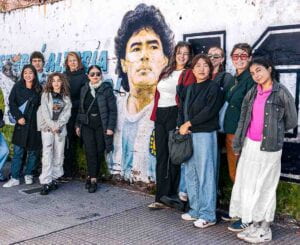
Students in Cecilia Palmeiro’s “City as Text” in front of a mural of Argentinian soccer star Diego Maradona in Buenos Aries’ La Boca neighborhood. Photo credit: Daniel Espinoza.
This fall in Palmeiro’s class, students considered the past and present of Buenos Aires through the lenses of immigration, environmental concerns, art and its role in political protest, and reproductive health. “In order to obtain the critical tools necessary to make sense and produce academic knowledge out of this experience, students read ‘Neoliberal Reform and Landscape Change in Buenos Aires, Argentina’ by David Keeling and the classic ‘The Right to the City’ by David Harvey,” explains Palmeiro.
This approach is not singular to NYU Buenos Aires, however, as students at NYU London traveled to the city’s Brixton district to learn about the area’s musical history and shifting racial makeup. And at NYU Accra, students focused on how migration and religion shaped the Ghanaian capital, visiting places of worship to learn in context.
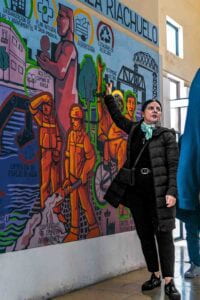
Architect Cecilia Alvis with “City as Text” students in front of a mural on the Nicolás Avellaneda Bridge. Photo credit: Daniel Espinoza
NYU Paris students studied the potential impacts of the 2024 Summer Olympics, learning about the social and environmental impacts of the upcoming event, and in NYU Berlin, students contextualized their learning with the history and landmarks of the Weimar Republic, the Third Reich, and the Cold War. “City As Text has played a significant role in the GLS curriculum since its inception. Our aim was to create a course centered on active engagement at the study away locations with a global perspective as its foundation,” concludes Kain.
Repurposed from NYU News
NYU Paris Staff Spotlight: Martina Faltova
In 2001 Martina Faltova was a study abroad student in Cambridge, England, when a chance encounter with an NYU professor led her to becoming his family’s au pair in New York City. Since her visa required a language course, she enrolled in Intermediate French at NYU. She loved the University so much that, when she returned home to the Czech Republic, she applied to work at NYU Prague. Now, more than 20 years later, she’s the assistant director for student life at NYU Paris.
Your job starts before students even arrive: organizing events, arranging housing, and prioritizing everyone’s safety and wellness. What inspired you to work with study away students?
I was a guest in another culture, and when I was leaving New York City, the family I lived with told me there was an NYU site in Prague and I should apply to it. And I loved that because I just came out of New York, I knew who the students were, and I felt like I could give back. Also, I love traveling, languages, meeting new people, and helping people learn more about Czech culture.
What role does language have in a student’s success at NYU Paris and NYU Prague?
In Paris the language course is required, so everyone has to take French. And it really makes your life easier. It’s a wonderful feeling when you can communicate, and it’s a really big sense of accomplishment. In Prague, though language courses are not required, learning Czech helps you make connections with the local people and understand the culture better too. Other language courses are offered at NYU Prague as well.
What are additional ways students can connect to local communities?
In Paris students can take courses at partner universities and hold internships. I also see students who choose to stay in a homestay, where they meet local families and become more connected to the place. In Prague I saw a lot of connections for the music students because they were performing in local places like pubs and would practice at other schools around Prague.
What attracts students to each site?
In Prague there’s centuries and centuries of history around you. It’s also very affordable. You really can do anything: easily buy tickets to the opera, go to nice restaurants, or live on a budget. In Paris the arts scene is incredible for anyone taking art or film courses. Here, students leave the classroom and see the paintings they discussed, and they wander the streets featured in famous movies.
You mentioned that NYU Paris is also branching out from the arts.
NYU Paris has changed a lot in the past six years. When I arrived, the majority of our courses were in the humanities. Now we have more and more science, technology, engineering, and mathematics courses. So we see a lot of students studying computer science and mathematics.
Which initiative are you most proud of?
At the beginning of the semester, we bring in people from local communities like nongovernmental and volunteer organizations and promote our cultural activities and trips. We invite all of our student and club leaders to promote their work. Students just mingle and learn about these opportunities, then they sign up for clubs. They talk to organizations about volunteering and helping. I just love that day.
Written by Marti Trgovich
NYU Students Can Study at the Korea Advanced Institute of Science and Technology
NYU science and technology students who want to study abroad but stay on track with their majors will have another option starting this year: the Korea Advanced Institute of Science and Technology. KAIST is “an innovative and dynamic institution, and it is among the top science and technology universities in the world,” says Nyoka Joseph, the assistant director of student services for the NYU International Exchange Program. “NYU students will join 3,600 KAIST undergraduates and 3,000 graduate students who live and learn on a 350-acre campus in Daejeon, a city of 1.5 million people in central South Korea.”
The exchange program is part of a partnership between NYU and KAIST that was launched in 2022 to combine each university’s distinctive strengths and drive advances in research while forging new industrial collaborations and investments. The partnership also lays the groundwork for KAIST’s first campus in the United States, which will be a joint venture with NYU in New York City. Students who are interested in studying abroad at KAIST must first apply to be nominated. Once they are nominated, they will receive access to the KAIST application.
NYU students can choose from a wide variety of preapproved courses at KAIST or seek approval from their academic adviser or dean to take other courses at the institute. The preapproved courses take advantage of KAIST’s strengths in industrial design, technology and culture, artificial intelligence, and Korean language. For students who want to focus on science and technology courses while building their Korean skills, the Korean International House provides one-on-one Korean language tutoring and is one of many resources for NYU students.
“Nearly everything that a student needs can be found, including academic facilities, nearly 30 dorms, athletic facilities, dining, and international student support services,” says Joseph, who recently visited the KAIST campus to tour the facilities and surrounding city. “There are 60 undergraduate clubs and organizations that NYU students can join. When I spoke to international students on campus, they talked about how that helped them feel they were settling into the school socially and that it was a great way to meet people outside of the classroom.”
Repurposed from Global Notebook
Meeting Point
Connecting NYU and the public through the NYU Abu Dhabi Institute
In 2008—two years before NYU Abu Dhabi welcomed its inaugural class—NYU established a presence in the city to begin building awareness about the type of events and dialogues the local community could expect the institution to host. The NYU Abu Dhabi Institute was a chance to create a relationship with the public, offering a space to address global challenges and contribute to a growing ecosystem of cultural institutions in the area.
Today, the institute is a center of advanced research as well as scholarly and creative activity. Its public programs and academic conferences bring together academics, professionals, and leaders from around the world to discuss research areas and topics of local and global significance. With some 45 public discussions and more than 25 academic conferences over the course of the year, the institute offers NYU a unique chance to give back to the intellectual culture of Abu Dhabi.
“We feature a range of topics that reflect the diversity of this global university, and we offer a space to talk about these complex problems from a variety of different perspectives,” says Senior Director of the Institute Maurice Pomerantz. “It’s a chance for our colleagues in Abu Dhabi to connect with colleagues from around the world and also speak not only to the standard academic audience but to professionals and policymakers from the larger community. A key part of our mission is to show the world the relevance of the modern university.”
Programs typically center on a theme connected to the global challenges of the moment; many of last year’s lectures focused on the environment, and upcoming ones will address artificial intelligence. Presenters often have multidisciplinary backgrounds, with knowledge that bridges fields, as well as experience in both academia and the broader world. Some discussions are in English and some are in Arabic, and the audience often includes NYU students and faculty, professionals, local school members, and families with children. The institute also hosts a series of lectures and events at NYU’s Washington Square campus. Last year alone, the institute led more than 30 events there.
Lectures encompass a variety of subjects and perspectives—one week a Booker Prize winner and an expert on Afghan music traditions may present, then the next week may feature a filmmaker who focuses on refugees’ stories. The institute archives past discussions on its YouTube channel, so anyone in the world can join the conversation. There are also numerous opportunities for students to participate, such as recommending faculty, helping with question and answer sessions at events, and much more.
In addition, the institute hosts peer reviewed academic conferences that can be proposed by faculty anywhere across NYU’s global network. The conferences advance NYU’s culture of research and offer a venue to many annual meetings of scholarly and academic societies from around the world. Regional and international conferences across most academic fields turn to the institute for specialized academic forums that discuss cultural, historical, artistic, and scientific themes.
“The institute is a rare opportunity to directly combine a public mission and a research mission,” Pomerantz says. “It’s a luxury to have a series of live talks and conferences today, especially ones that are relevant locally and meaningful on a global scale. I think this has really become something of a treasure here in Abu Dhabi.”
Written by Sarah Bender
The Rise of Experimental Circus in Prague: Artistic Research over Entertainment
It’s early evening and the National Theatre: The New Stage in Prague is sold out for the premiere show of Krajina těla or Land of Body. Sounds of waves crashing and a cello fill the hall as aerial acrobat Alžbeta Tichá climbs up a dangling rope, twisting, flipping, and falling dangerously fast before pulling the rope taut. While she moves through her choreography, eight LED screens placed around the stage show close-up images of hair follicles.
This is circus. Or, a kind of circus. With its understated exploration of physicality—a visual poem through movement—Krajina těla is an example of the experimental circus style emerging in the Czech Republic. Decidedly different from the theatrical and showy version of modern circus that Czech companies have mastered, the change comes as a new generation of performers enters the field, bringing with them new techniques and concepts.
Czech contemporary circus was created right after the fall of communism in 1989. “Metaphorical, symbolic—the circus as a physical form was there as a metaphor for something else. Like you are on the trapeze, so you are representing a bird, for example,” says Veronika Štefanová, research supervisor of CIRQUEON, a Prague-based circus center. Theatre folk were inspired by touring European circus companies, but, without formal training to make stand-alone circus shows, they began incorporating these elements into their theatre productions.
The style’s popularity exploded in 2004 with the annual summer festival, Letní Letná, started by Jiří Turek, who has a background in dancing, miming, and alternative theatre. When he first hosted the festival in Prague, there were 6,000 attendees. Now it attracts 60,000 people, making it the biggest contemporary circus festival in the Czech Republic. “We invite the biggest companies,” Turek says of his festival direction. “We must do it. The smaller festivals cannot invite them; it is too expensive.” The necessity of featuring large companies has developed a large, unvarying style of circus—commercial and theatrical.
Cirk La Putyka is a case in point. It is the latest company in Prague, currently performing Cesty, which features more than 50 performers in a classic circus top. The acrobats, dancers, and actors wear flashy costumes while thunderous sound effects accentuate the stunts. In one act nine women flip around Hula-Hoops spinning high in the air. In another, a man walks amid the audience seats and breathes out orange flames. These moments are interspersed with storytelling and dialogue. The show is a glamorous spectacle.
This “wow” factor is necessary, explains researcher Štefanová. “They would like to really live on circus and work only in circus, and it means you have to sell a lot of tickets.” Cirk La Putyka and other large companies have successfully done so, regularly selling out shows. In recent years the experimental shows have gained popularity with new techniques by younger artists. The kids, who 10 years ago signed up for informal circus classes at CIRQUEON, are of a professional age now. Tichá, the rope acrobat in Krajina těla, performs in several avant-garde shows. Along with Krajina těla, she is part of Thin Skin, a production staged in the DOX Centre for Contemporary Art.
Tichá emphasizes that she is not so much entertaining an audience as pushing the limits of her art, conducting a kind of research while onstage. “When I go on the rope, I have to be present. There is no chance to think about anything else.”
Repurposed and edited with permission by Dispatches
Around the World in 97 Years: A Brief History of NYU’s Global Network
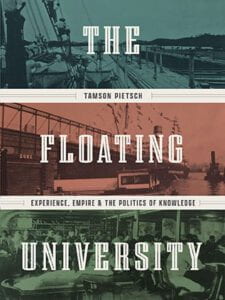 Long before study abroad was a rite of passage for curious students, NYU recognized the many merits of an international education. While the University founded its first study away site in 1958, Professor James E. Lough took 350 NYU students on a for-credit sailing trip around the world back in 1926, an experience he dubbed the “Floating University.” Tamson Pietsch, associate professor in social and political sciences and director of the Australian Centre for Public History at the University of Technology Sydney, detailed this little known journey in her recent book, The Floating University: Experience, Empire, and the Politics of Knowledge.
Long before study abroad was a rite of passage for curious students, NYU recognized the many merits of an international education. While the University founded its first study away site in 1958, Professor James E. Lough took 350 NYU students on a for-credit sailing trip around the world back in 1926, an experience he dubbed the “Floating University.” Tamson Pietsch, associate professor in social and political sciences and director of the Australian Centre for Public History at the University of Technology Sydney, detailed this little known journey in her recent book, The Floating University: Experience, Empire, and the Politics of Knowledge.
“NYU actually ran the very first study abroad program for academic credit in the United States and the world,” Pietsch asserted in a recent discussion facilitated by NYU’s Dr. Jini Kim Watson, professor of English and comparative literature and faculty liaison at NYU Sydney. During their conversation, Pietsch shared her work with Dana Burde, associate professor of international education at the Steinhardt School of Culture, Education, and Human Development, and Shirin Nadira, assistant director of the NYU Office of Global Awards.
Pietsch’s book details the fascinating history of this educational experiment as well as its implications for higher education. “A contest emerged in the 1920s between expertise and experience as the foundation of knowledge claims about the world,” she explains. For eight months, 350 students and another 150 crew members traversed the globe on a ship, taking a variety of courses and disembarking at nearly 50 ports. Much like NYU’s global network today, the advertising materials lauded the voyage as an opportunity for students to “develop the ability to think in world terms through firsthand contact with places, people, and problems.” Indeed, students met recognizable figures such as Gandhi and the Pope. “The basis of the voyage was that you can teach students to be global citizens at sea—you can teach worldly-mindedness,” says Pietsch. However, the press covered students’ antics as much as their learning, and it would be some years before NYU students once more studied abroad.
More than three decades later, in 1958, NYU established the first academic center in its global network, NYU Madrid. There, students hone their Spanish language skills while immersing themselves in the Spanish capital’s vibrant culture. Then, in 1969, NYU Paris became the second site, founded as a center for immersive French language study. Today, students from a diversity of fields come together to visit world-renowned museums and key historical sites while getting the opportunity to supplement their coursework with classes at French universities. In the years that followed, the NYU community established a dozen additional global sites, including two degree-granting campuses in Abu Dhabi and Shanghai.
As our world fractures, reconnects, and evolves, NYU’s global network has continued to grow and change. “In a way, I think that not much has changed,” concludes Pietsch. “The form of encountering engagement with the world does that same work of helping students understand the place of their nation in the international order.”
Written by Dana Guterman
On Art and Diasporic Aesthetics: The Art Scenes of Berlin and New York City
Cecilia Bien, a Global Research Initiative Fellow in Berlin, discusses the differences and similarities between two cosmopolitan art scenes, Berlin’s and New York City’s, as well as her thoughts on what makes art considered art with Nina Katchadourian, a clinical professor on the NYU Gallatin School of Individualized Study faculty.
Their conversation has been condensed for clarity.
Cecilia: I’m interested in what is not yet framed as art. I’m interested in attitudes, the impulse. I am thinking about how to show “marginal” work in a contemporary context without the feeling of it being used for representation or shown in a way that has to be overexplained.
Nina: When you compare Berlin to New York City, what are the differences or similarities you see in fashion, style, or haircuts, for example, or how people walk down the street?
Cecilia: Reference to club culture doesn’t happen the same way in New York City as it does here. Fashion in Berlin subscribes way less to trends in favor of individuality—even if it’s ugly. I find that refreshing because maybe it means that the hierarchy of taste is always being questioned.
There are different codes here. A lot of the styles in Berlin seem to be more lived. I also see how subcultures can complicate expectations of diasporas. On the flip side, I feel like a lot of what gets absorbed by the cultural industry in Berlin is appropriated from what’s been happening for a while in New York City.
Nina: We’ve talked in a lot of different contexts about when something from the periphery gets absorbed into the mainstream. I think you have a good antenna for this and that it’s deeply interesting to you. How can you tell when something like this is happening?
Cecilia: Recently, I’ve been focusing on when and why certain tastes change. When an incisive political message gets diluted, the aesthetics attached to it become normalized. I think about what the term “diasporic aesthetics” means to people who understand things through representation. Diaspora is so layered and complex, but it seems to be becoming a euphemism for a certain kind of woke taste different enough from the norm but only with a certain kind of difference being accepted. It cannot feel bourgeois, but it must be digestible though not necessarily understood, and it must be appreciated without being deemed “trashy.” When I hear such aesthetics embraced as “beautiful,” I wonder what makes them so and which cultural tides had to change or switch course for them to be considered that way.
Nina: I’ve always known you as someone who thinks from two positions: a maker and a critical analyst of systems and institutions. When you think from those two positions, does one enhance the other? I know you’ve recently done some work as a curator. Do you think curating is a type of making?
Cecilia: I think it can be because it’s a way to conceptualize the making of an idea. I guess curating is also the making of an exhibition or the making of an argument. That said, making an exhibition about a so-called diasporic group does not count, for me, as the making of an argument. For example, I am no longer an Asian American outside of America. At least, this is how I feel I am perceived here. There are countless versions and political positions and reasons why people move from place to place, so how can you group them all by a prescribed cultural background? It’s quite superficial and certainly not enough to base a concept on.
Nina: What are some examples of an exhibition addressing a “vague diaspora,” and when do you think it works and when do you think it doesn’t?
Cecilia: A lot of times these exhibitions are accompanied by super research-based texts, which I often have a hard time with even though I also write some myself. Sometimes, I’m not sure what the relationship should be to the artwork, like whether it should exist in parallel as a complementary work or whether it should walk the viewer through, because a lot of times it is hard or impossible to place the work in an art historical context or within a canonical framework, which is what many viewers going to a museum or institution might expect. And still, the curatorial choices for non-Western art are also often from a Western-educated lens.
So these rather heavy-handed texts might be trying to contextualize the works in a new temporality but often come off as dry justifications of why the work is allowed to be there. There’s something slightly insecure in the overcompensation, and it feels a little like it’s not completely sure of what it should be doing.
At the moment, I work at an archive that is a collection of people globally reacting to and rejecting the canon and art history, a global network which came to be called Fluxus. In Prague Milan Knížák’s Aktual Walk considers everything between how to wear a garment and walk down the street to how to interact provocatively. This kind of work is impossible to pin down as an art object, as something that can be placed in a museum, or something understood purely by looking.
So it’s interesting to try to give these works significance without placing them in categories structured by a hierarchical order. Every day, we deal with questions of how to contextualize collective action outside of art history, how to show what is not necessarily called art, as art, and whether we should do it at all when most of what was created was ephemeral and meant for impermanence. But I still want to curate a show with Knížák’s drawings and sketches and correspondences between the artists in the collection as a way to show the very attitude that we’re talking about right now.
Repurposed and edited with permission by the NYU Berlin blog
Cecilia Bien writes and organizes programs in Berlin, for artists as well as para-institutions such as SAVVY Contemporary and Archivio Conz, a Fluxus archive. Previously working in applied art and fashion contexts in New York City, she came to Berlin to complete studies in art and cultural theory, recenter her critique of dominant narratives, and understand her own subjectivity outside of an identity politic tied to living in the US. Her current practice concerns diasporic aesthetics and situating play, chance, and community coming from the periphery in the context of art.
Nina Katchadourian is an interdisciplinary artist whose work includes video, performance, sound, sculpture, photography and public projects. Her video Accent Elimination was included at the 2015 Venice Biennale in the Armenian pavilion, which won the Golden Lion for Best National Participation. In 2016 Katchadourian created Dust Gathering, an audio tour on the subject of dust, for the Museum of Modern Art. A traveling solo museum survey of her work entitled Curiouser opened in March 2017 at the Blanton Museum of Art and toured to the Cantor Art Center at Stanford University in fall 2017. It will conclude at the BYU Museum in Provo, Utah in March 2018. An accompanying monograph, also entitled Curiouser and edited by curator Veronica Roberts, is available from Tower Books. Katchadourian’s work is public and private collections including The Metropolitan Museum of Art, Blanton Museum of Art, Morgan Library, San Francisco Museum of Modern Art, Margulies Collection, and Saatchi Gallery. She has won grants and awards from the New York Foundation for the Arts, the Anonymous Was a Woman Foundation, the Tiffany Foundation, the American-Scandinavian Foundation, and the Nancy Graves Foundation. Katchadourian lives and works in Brooklyn and she is a clinical professor on the faculty of NYU Gallatin. She is represented by Catharine Clark Gallery, San Francisco, and Pace Gallery, New York.
Service and Immersive Education in Calais
NYU London and NYU Paris students recently had the opportunity to go on a volunteer trip to the French port city of Calais. Situated on the Strait of Dover, the narrowest part of the English Channel, Calais is an important transfer point for people who are seeking asylum en route to the United Kingdom. The group of about 40 students supported Care4Calais, a nongovernmental organization that provides refugees with food, clothing, shelter, health care, and legal resources. Students helped out with various tasks, like sorting donations of clothing, food, and toiletries and cooking meals for volunteers. They also toured the Calais Lighthouse and WWII Museum and tasted local cuisine at Au Côté d’Argent.
A Deeper Understanding of the European Refugee Crisis
For Margi DiPietro, a junior Global Liberal Studies major on the prehealth track who studied away at NYU Paris, traveling to Calais was an ideal opportunity to learn in real time the challenges asylum seekers and French citizens encounter. Moreover, she perceived an opportunity to build relevant experiences toward her goal of becoming a doctor for Médecins Sans Frontières. Prior to the trip, Margi gained insight into relevant issues in the course France and Islam. “We learned about the Calais Jungle and analyzed information about immigration in France and the French responses to the refugee crisis,” she says. “I had not realized that there are camps of this scale in Calais, or that refugees are trying to cross the English Channel on boats like you see in the Mediterranean.”
Unforgettable Personal Connections
Kaila Jones, a junior Theatre major studying away at NYU Paris, also joined the trip. Kaila has been volunteering since childhood and describes how taking part in service opportunities while studying away was a chance to find common ground with people who use different languages and come from diverse backgrounds. Care4Calais changed Kaila’s perspective on refugees. “I had some prior expectations and assumptions about what these people would be like,” Kaila admits. “I was surprised to see so many smiling faces, and how people who had so little were willing to give and share with me. Despite everything they were dealing with, they still made room for fun, laughter, and happiness. Seeing that firsthand hit my heart in ways I will never forget.”
The Importance of Education Outside the Classroom
Ahmed Nasri, communications and student engagement coordinator at NYU Paris and one of the trip’s organizers, emphasizes the importance of taking advantage of cultural immersion opportunities while studying away. “The trip offered a transformational shift in perspective that enriched students’ academic journeys, since their theoretical knowledge was grounded in a real world context.” He explains further: “There is a significant difference between learning about a subject theoretically and experiencing it firsthand. This trip to Calais aimed to bridge that gap. While we can absorb information about the refugee crisis and immigration challenge from books and lectures, witnessing it in person amplifies students’ understanding.”
Written by Auzelle Epeneter
The New Now Summit: Informing and Inspiring NYU Los Angeles Students
Last semester NYU Los Angeles presented The New Now Summit, bringing actors, writers, educators, artists, executives, and creative technologists together to discuss the future of filmed content and how technological, societal, and market forces will affect it.
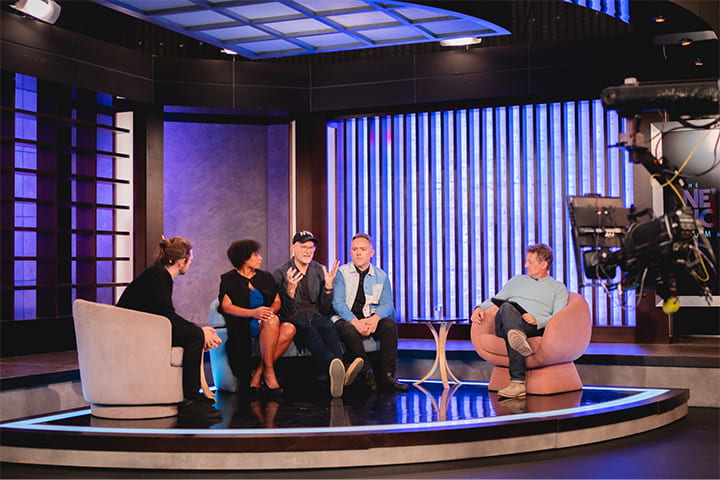
Tisch alumni, filmmaker and actor Alex Winter moderates a panel entitled AI Created Entertainment, Inherent Bias and Opportunities for Change, featuring Tisch alum Oscar Sharp, cybersecurity expert, Lindsay Nuon, and Tisch faculty Gabriel Barcia-Colombo and Dan O’ Sullivan.
NYU Los Angeles sponsored the event with help from a Global Opportunity Grant awarded by the Office of Global Programs. With additional funding from the NYU Alliance for Public Interest Technology, the NYU site felt that they could produce and facilitate an event to meet the moment(s) of the evolving Hollywood landscape. From technological influences on storytelling and inclusive representation to the value and exploitation of intellectual property (IP), the NYU Los Angeles team knew what they wanted conversations to focus on. The summit addressed several driving questions: How can diverse voices be supported and amplified if prebranded or known IP is necessary to break through the media clutter? If tech is created with the inherent biases of humans, how can it be inclusive? And, with these things in mind, how can one ethically work with technology in creative industries?
Thought leaders from NYU’s campus in New York City, including Dr. Charlton McIlwain, vice provost and professor of media, culture, and communication at the Steinhardt School of Culture, Education, and Human Development; Gabriel Barcia-Colombo, associate arts professor in the Interactive Telecommunications Program at the Tisch School of the Arts; and Dan O’Sullivan, associate dean of the Tisch Institute of Emerging Media, were among panelists who informed and inspired audience members. In fact, much of the audience were students from the NYU Los Angeles fall 2023 cohort. For Zoë Bolden, a Film and Television major, the most impactful panelist was Kelly Mi Li. “It was interesting to hear how she took an idea she had in 2013 and turned it into the Bling Empire, which premiered in 2021,” Zoë says. “It was inspiring to see how she never gave up on her idea. My favorite piece of advice was when she said you should always stay true to a project that you have created.”
Though the industry is ever-changing and challenging, students left the event emboldened for the future. Luke Nguyen, an NYU Abu Dhabi student majoring in Film and New Media, says he learned that “Opportunities will always show up when I show up. Don’t be afraid to fail; we get better when we fail. Know that failure is taking us where we need to be.” Zoe Stevens, a Theatre major from Tisch, adds, “There will be a lot of ‘nos’ before ‘yes.’ I have to fight for the rooms I am supposed to be in. I can start that by surrounding myself with good people who lift me.”
Repurposed and edited with permission by NYU Los Angeles
